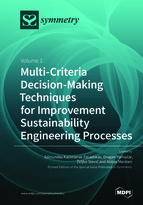Multi-Criteria Decision-Making Techniques for Improvement Sustainability Engineering Processes
A special issue of Symmetry (ISSN 2073-8994). This special issue belongs to the section "Computer".
Deadline for manuscript submissions: closed (1 January 2020) | Viewed by 180932
Special Issue Editors
Interests: operations research; optimization and decision analysis; multicriteria decision making; multiattribute decision making (MADM); decision support systems; civil engineering; energy; sustainable development; fuzzy sets theory; fuzzy multicriteria decision making; sustainability; management; game theory and economical computing knowledge management
Special Issues, Collections and Topics in MDPI journals
Interests: multi-criteria decision making problems; computational intelligence; sustainability neuro-fuzzy systems; fuzzy; rough and intuitionistic fuzzy set theory; neutrosophic theory
Special Issues, Collections and Topics in MDPI journals
Interests: logistics; supply chain management; transport; traffic engineering; multicriteria decision-making problems; rough set theory; sustainability; fuzzy set theory; neutrosophic theory
Special Issues, Collections and Topics in MDPI journals
Special Issues, Collections and Topics in MDPI journals
Special Issue Information
Dear Colleagues,
The success of any activity and process depends fundamentally on the possibility of balancing (symmetry) needs and their satisfaction. That is, the ability to properly define a set of success indicators. The application of the developed new multi-criteria decision-making (MCDM) methods can be eliminated or decreased by decision-makers’ subjectivity, which leads to consistency or symmetry in the weight values of the criteria. Decision making on complex engineering problems including individual process decisions requires an appropriate and reliable decision support system. Fuzzy set theory, rough set theory, and neutrosophic set theory which belong to MCDM techniques are very useful for modelling complex engineering problems with imprecise, ambiguous, or vague data. Sustainability in engineering is one of the most discussed topics in recent years, and represents one of the key factors in engineering sustainable development and optimization. Sustainable multidisciplinary approaches based on MCDM techniques enable easier process technology in the future.
This Special Issue on “Multi-Criteria Decision-Making Techniques for Improvement Sustainability Engineering Processes” aims to incorporate recent developments in the area of sustainable engineering processes. Topics include, but are not limited to, the following:
- MCDM optimization in sustainable engineering,
- Environmental sustainability in engineering processes,
- Sustainable multi-criteria production and logistics processes planning,
- Integrated approach for modelling processes in engineering,
- New trends in the multi-criteria evaluation of sustainable processes,
- Multi-criteria decision-making in strategic management based on sustainable criteria.
Conclusion:
Engineering is the application of scientific and mathematical principles for practical objectives such as the processes, manufacture, design, and operation of products, while accounting for constraints invoked by environmental, economic, and social factors. There are various factors needing to be considered in order to address engineering sustainability, which is critical for overall the sustainability of human development and activity. In these regards, in recent decades, decision-making theory has been a subject of intense research activities due to its wide applications in different areas, such as sustainable engineering and environmental sustainability. The decision-making theory approach has become an important means of providing real-time solutions to uncertainty problems, especially for sustainable engineering and environmental sustainability problems in engineering processes. We hope that this Special Issue will stimulate both theoretical and applied research in the related fields of sustainability engineering processes. It is certainly impossible to provide in this short editorial a more comprehensive description for all articles in this Special Issue. However, we sincerely hope that our effort in compiling these articles will enrich our readers and inspire researchers with regard to the seemingly common, but actually important issue of decision-making and fuzzy decision-making approaches for sustainable engineering processes.
Prof. Edmundas Kazimieras Zavadskas
Dr. Dragan Pamučar
Dr. Željko Stević
Dr. Abbas Mardani
Guest Editors
Manuscript Submission Information
Manuscripts should be submitted online at www.mdpi.com by registering and logging in to this website. Once you are registered, click here to go to the submission form. Manuscripts can be submitted until the deadline. All submissions that pass pre-check are peer-reviewed. Accepted papers will be published continuously in the journal (as soon as accepted) and will be listed together on the special issue website. Research articles, review articles as well as short communications are invited. For planned papers, a title and short abstract (about 100 words) can be sent to the Editorial Office for announcement on this website.
Submitted manuscripts should not have been published previously, nor be under consideration for publication elsewhere (except conference proceedings papers). All manuscripts are thoroughly refereed through a single-blind peer-review process. A guide for authors and other relevant information for submission of manuscripts is available on the Instructions for Authors page. Symmetry is an international peer-reviewed open access monthly journal published by MDPI.
Please visit the Instructions for Authors page before submitting a manuscript. The Article Processing Charge (APC) for publication in this open access journal is 2400 CHF (Swiss Francs). Submitted papers should be well formatted and use good English. Authors may use MDPI's English editing service prior to publication or during author revisions.
Keywords
- fuzzy set theory
- rough set theory
- neutrosophic set theory
- sustainable development
- modelling in engineering
- sustainable waste management
- sustainable processes
- decision making
- environmental engineering
- engineering sustainability









